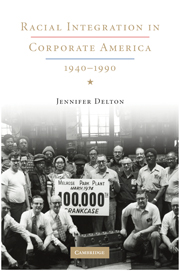Book contents
- Frontmatter
- Contents
- List of Tables
- Introduction
- PART I COLOR-BLIND GROUNDWORK, 1940–1961
- 1 The African American Struggle for Jobs
- 2 Fair Employment Is Good Business
- 3 Racial Liberalism and the Mid-Twentieth-Century Businessman
- 4 Human Relations in Management
- 5 Human Relations at International Harvester and Pitney-Bowes
- PART II COLOR-CONSCIOUS ASCENDANCY, 1961–1990
- Epilogue: From Affirmative Action to Diversity
- Statistical Tables
- Bibliography
- Acknowledgments
- Index
- References
4 - Human Relations in Management
Published online by Cambridge University Press: 05 June 2012
- Frontmatter
- Contents
- List of Tables
- Introduction
- PART I COLOR-BLIND GROUNDWORK, 1940–1961
- 1 The African American Struggle for Jobs
- 2 Fair Employment Is Good Business
- 3 Racial Liberalism and the Mid-Twentieth-Century Businessman
- 4 Human Relations in Management
- 5 Human Relations at International Harvester and Pitney-Bowes
- PART II COLOR-CONSCIOUS ASCENDANCY, 1961–1990
- Epilogue: From Affirmative Action to Diversity
- Statistical Tables
- Bibliography
- Acknowledgments
- Index
- References
Summary
The idea of employing competent industrial relations personnel is no longer on trial.…Today it is considered good business to employ individuals whose handling of employer-employee relations is expected to result in more favorable management-employee understanding…and therefore more production at less cost.
Sara Southall, 1950The development of equal employment opportunities cannot be divorced from the structure of an organization, especially its overall management of administrative matters.
Lewis Ferman, 1968Making the decision to hire or promote black workers into traditionally white jobs was one thing. Implementing it was quite another. The transition to an interracial workforce during and after World War II was often accompanied by violence and resistance, but it was made easier by the prevalence of managerial practices that stressed “human relations.” Designed to alleviate labor tension and increase productivity, the human relations approach to management was especially attuned to issues of assimilation, adjustment, and social change and thus proved sensitive to the problems raised by fair employment and workplace integration. It is difficult to see how integration could have proceeded without human relations innovations such as formalized employment procedures, a recognition of group dynamics, in-house training and education, community relations programs, and sensitivity training. Essential to the eventual success of integration was the human relations belief that the workplace was a social system, not a collection of individuals.
- Type
- Chapter
- Information
- Racial Integration in Corporate America, 1940–1990 , pp. 99 - 129Publisher: Cambridge University PressPrint publication year: 2009



